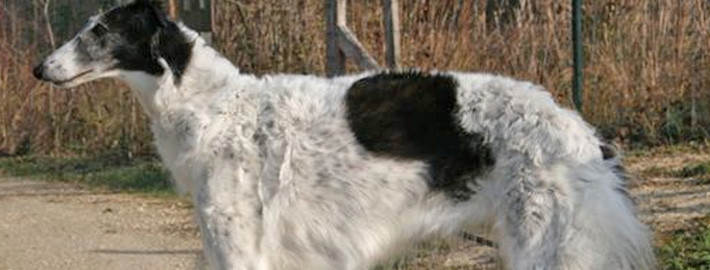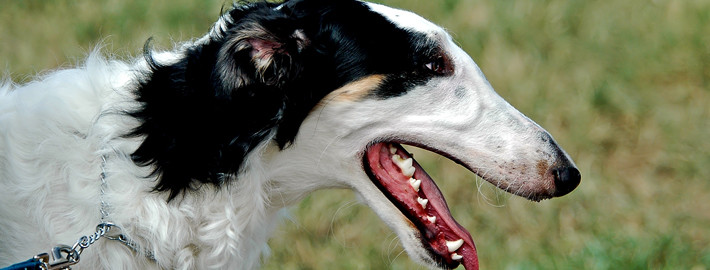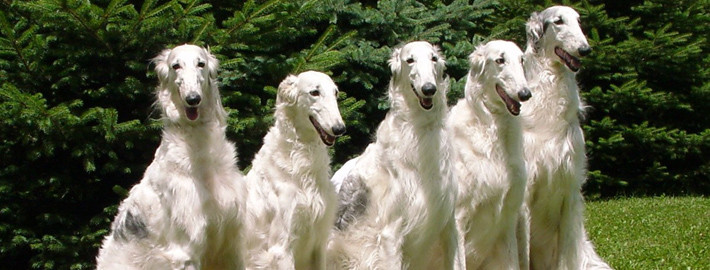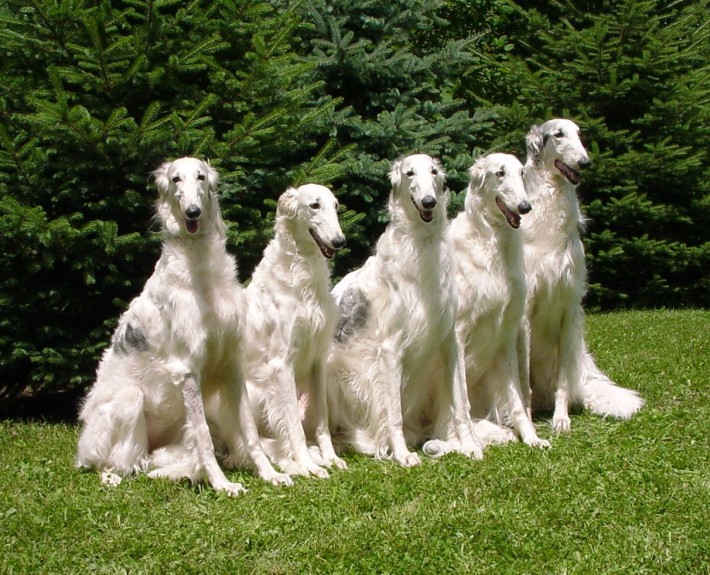What makes the Borzoi Unique?
These dogs draw their name from the Russian word for “swift” and this regal breed is certainly that. Although they are ill-suited for city life, Borzois make great pets for families dwelling in rural areas that have older children.
Breed Groups
Page Contents
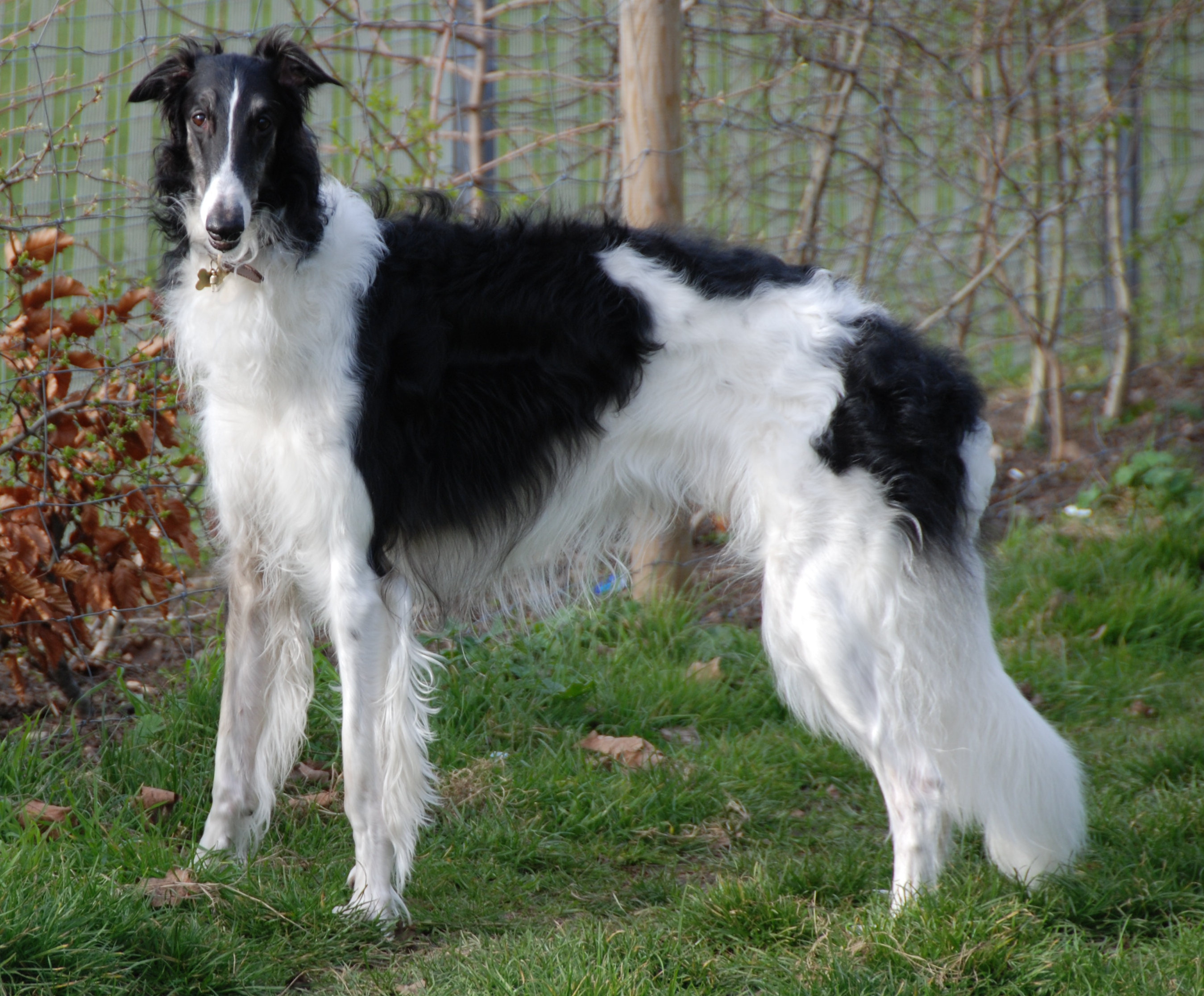
SnapShot
Is the Borzoi Right For You?
The Borzoi is similar in shape to the greyhound. It has a narrow, slightly domed head, with almost no stop. The long muzzle is slightly arched. The teeth meet in a level or scissors bite. The large nose is black. The dark eyes have a slant to them. The small ears lay back on the head. The back line is arched slightly upward and the chest is narrow, but deep. The front legs are straight. The tail is set low with a curve. The coat is long, silky, flat, or wavy. Borzois are active outdoors, quiet indoors. They are intelligent, sensitive, and reserved around strangers. They will chase small animals or big animals, and care must be taken to make sure they are trained. Some say they are generally good with children, but precaution should be taken as many sources indicate they do not take kindly to teasing.
In 5 Words
- Athletic
- Gentle
- Quiet
- Respectful
- Intelligent
Characteristics
Learn About the Borzoi
General Description
These dogs are built rather like greyhounds with slightly arched backs and deep, narrow chests but this breed is much larger and stronger overall. They have a narrow, slightly domed head that has almost no stop. Their long, slightly arched muzzles have teeth that meet in a level or scissors bite. Borzois have black noses and dark slanted eyes. Their small ears lay back on their heads. Their curved tails are carried low. When standing still or in motion, the breed should be elegant and graceful, with nicely flowing lines.
Size
Males of this breed average slightly less than 28 inches in height and have a weight between 75 and 100 pounds. Female Borzois are slightly smaller. On average, they weight between 60 and 85 pounds. They are also generally stand about 26 inches high at the withers.
Coat
These dogs have a long, thick coat that can be silky, flat, or wavy. This provides them with protection against the frigid Russian winters. They have hair on their tails, necks, and hindquarters that is lengthier than that on the rest of their bodies. Borzois also come in a variety of colors. White, tan, black, grey, and golden hues are all common colorations. This breed can have black or golden markings. Mixed colorations are also permitted.
Short History of the Borzoi
The Borzoi breed has been in existence since the 1500s, if not before then. The breed had a curious beginning. A notable story involves a Russian duke tried to import several Arabian sight hounds, but the cold weather proved hazardous to the health of these breeds. He then began crossing the Arabian breeds with native long legged shepherd dogs and Tartar coursing hounds to produce the cold-resistant dogs that are now known as the Borzoi. These dogs may share ancestors with the Greyhounds and the Lapp sled dogs. In the beginning there were several different Borzoi strains such as the Borzoi Tartar, the Sudanese Borzoi, and the Turkoman Borzoi.
These dogs had been bred by the Russian aristocracy for the purpose of hunting wolves and could hunt in packs that numbered as many as a hundred dogs. It was more typical for Borzoi to track their prey in groups of three. The trio would simultaneously attack and thrown down a wolf so that their owners could either dispatch or release the animal, as they saw fit. Borzois were usually given away as gifts by the Russian who tended to keep them as pet and they were also popular with the Imperial family as well. Around the1850s, the breed made its way to Britain. By the 1890s, this breed had found a home in the United States as well. In 1981, Borzois were officially recognized by the American Kennel Club (AKC).
During the 1917 Russian Revolution, this breed almost became extinct because these were seen as a royal icon and subsequently killed. The exported Borzois were the reason the breed survives to this very day. In the early Hollywood era, these dogs became known for being the glamourous pets of movie stars but today Borzois are more commonly lure coursing contestants or show dogs. However, they may also be used to control coyote populations in the American West and other areas.
Temperament
Borzois are generally well-manned dogs indoors, but will chase anything that runs when they are outside. Therefore, they are not recommended for families with cats or other small animals. This breed will also pursue large animals so caution should be exercised if the dogs are going to be around cattle and/or sheep. This breed is said to be generally good with children but they may not be playful enough to suit some families. Borzois do not handle roughhousing or teasing well so owners should also be aware of this fact. Most of these dogs are also aloof around strangers. However, Borzois are known to be affectionate towards their families.
Caring for Your Borzoi
General Health
These dogs generally live between 10 and 12 years in good health. However, this breed is prone to bloat. Large meals should be avoided, but rather should have small meals two or three times a day and exercise after meals should be avoided. These dogs are additionally sensitive to drugs, especially anesthesia. Gastric torsion is a major problem for Borzois. These dogs are also not recommended for owners who live in warm climates as they respond badly to the heat. Owners may also want to serve food to their pet in a raised dish to prevent these tall dogs from having to bend down far to reach their meals.
Grooming & Bathing
These dogs should be either dry shampooed or bathed on a regular basis but are typically considered a clean breed. Borzois may also need their toenails clipped and the hair that grows on their feet trimmed every so often.
Daily
This breed needs plenty of exercise. Long daily walks are recommended and Borzois should not be allowed off the leash but these dogs will chase small animals if given the opportunity to do so. They will also need ample playtime in a large, fenced-in area every day.
Weekly
Their coats should be brushed regularly two to three times a week to keep them from shedding everywhere. It is recommended that owners use a sturdy bristle or pin brush while grooming their dogs and check for mats that may have formed at the leg joints or behind the ears. These should be snipped free when noticed. Owners may also want to brush their pet’s teeth regularly to prevent bad breath and the onset of periodontal disease.
Monthly
All dogs require flea, heartworm and tick medications on a monthly basis.
Exercise & Training
It is recommended that owners start training their dogs when they are young to prevent them from indulging in destructive behaviors. These dogs are not considered difficult to housebreak and can be easily taught basic indoor manners. Training can be a challenge after that, though, if owners don’t exert any effort in making learning fun for their dogs. Reward based training is an effective method with this breed. Yet these independent dogs respond badly to harsh punishments because they tend to be quite sensitive and some are incredibly timid. Yelling at them will only make the situation worse. Of course, Borzois are very active animals and need a lot of exercise to be content in their environment. They can happily live outdoors in temperate environments if they have other pets for company. Otherwise, these dogs should sleep indoors with their human families.
Sources: Previously written materials, Animal Planet, American Kennel Club, WOOF-pedia, VetStreet

